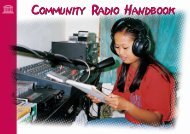Chapter 2. Progress towards the EFA goals - Unesco
Chapter 2. Progress towards the EFA goals - Unesco
Chapter 2. Progress towards the EFA goals - Unesco
You also want an ePaper? Increase the reach of your titles
YUMPU automatically turns print PDFs into web optimized ePapers that Google loves.
0<br />
1<br />
0<br />
CHAPTER 2<br />
2<br />
Education for All Global Monitoring Report<br />
Reducing <strong>the</strong><br />
cost burden on<br />
households is<br />
a priority for<br />
improving access<br />
Table <strong>2.</strong>8: Targets for <strong>the</strong> global costing exercise<br />
Goal<br />
Early childhood care and<br />
education<br />
Universal primary education<br />
Expansion of lower secondary<br />
schooling<br />
Adult literacy<br />
Gender parity and equality<br />
Education quality<br />
Criteria for achievement<br />
by 2015<br />
Provision of pre-primary schooling for all<br />
children living below <strong>the</strong> poverty line<br />
Provision of school places of good quality<br />
for all children of primary school age<br />
Provision of places in lower secondary school<br />
for all children completing primary school<br />
Provision of sufficient literacy programme<br />
places for illiterate adults to ensure that<br />
illiteracy rates are halved from 1999 levels<br />
Achievement of gender parity in primary<br />
enrolment rates and lower secondary<br />
transition rates, and male and female literacy<br />
rates at or above target levels<br />
Inclusion of a range of quality-enhancing<br />
interventions at each education level<br />
Average for 46 low-income countries<br />
(circa 2007)<br />
Pre-primary gross enrolment ratio = 16%<br />
Primary gross enrolment ratio = 95%<br />
Primary net enrolment ratio = 72%<br />
Primary to secondary transition rate = 69%<br />
Lower secondary gross enrolment ratio = 44%<br />
Adult literacy rate = 59%<br />
—<br />
—<br />
Target<br />
for 2015<br />
52%<br />
108% 1<br />
100%<br />
100%<br />
83%<br />
80%<br />
Full parity<br />
See Table <strong>2.</strong>9<br />
Notes: Targets for early childhood education and adult literacy are country-specific. The targets given in <strong>the</strong> table are unweighted averages for all countries covered.<br />
1. GER targets are country-specific but imply full enrolment of primary school age children with a maximum of 10% repetition.<br />
Box <strong>2.</strong>27: Basic education financing<br />
in <strong>the</strong> Democratic Republic of <strong>the</strong> Congo and <strong>the</strong> Sudan<br />
Estimating education costs for countries affected<br />
by conflict is problematic. In many such countries,<br />
access to <strong>the</strong> type of data required for a<br />
meaningful assessment of need is often lacking.<br />
households, which must cover half of overall<br />
costs in <strong>the</strong> Democratic Republic of <strong>the</strong> Congo<br />
and a third in <strong>the</strong> Sudan. Reducing <strong>the</strong> burden<br />
on households is a priority for improving access.<br />
Innovative work for <strong>the</strong> global costing exercise<br />
set out in this chapter has made it possible<br />
to include several conflict-affected countries.<br />
UNESCO carried out detailed country-level<br />
analysis for <strong>the</strong> Democratic Republic of <strong>the</strong> Congo<br />
and for <strong>the</strong> Sudan, where conflict has seriously<br />
compromised education planning and data<br />
collection. The analysis drew on recent surveys,<br />
including a 2006/2007 education census for <strong>the</strong><br />
Democratic Republic of <strong>the</strong> Congo (<strong>the</strong> first in<br />
twenty years), as well as detailed evidence on<br />
costs from a range of donor, international agency<br />
and national ministry sources.<br />
This research draws attention to several important<br />
concerns. In both countries, <strong>the</strong> collapse of public<br />
financing for education has shifted <strong>the</strong> burden to<br />
The case studies also highlight differences within<br />
each country. In <strong>the</strong> Democratic Republic of <strong>the</strong><br />
Congo, a legacy of weak governance and conflict<br />
stretching back over many years has resulted in<br />
a highly fragmented education system. Conflict<br />
and insecurity in some regions, notably <strong>the</strong> east,<br />
continue to hamper reconstruction prospects.<br />
In <strong>the</strong> Sudan, conflict has led to <strong>the</strong> development<br />
of separate political administrations and parallel<br />
education systems in <strong>the</strong> north and south.<br />
Financing for <strong>the</strong>se systems varies. The best<br />
estimates indicate that <strong>the</strong> north devotes 13%<br />
of government revenue to education, compared<br />
with 6% in sou<strong>the</strong>rn Sudan, leading to large<br />
differences in spending per pupil. Primary school<br />
pupil/teacher ratios are 33:1 in <strong>the</strong> north and 51:1<br />
in <strong>the</strong> south.<br />
Source: Chang et al. (2009).<br />
122
















